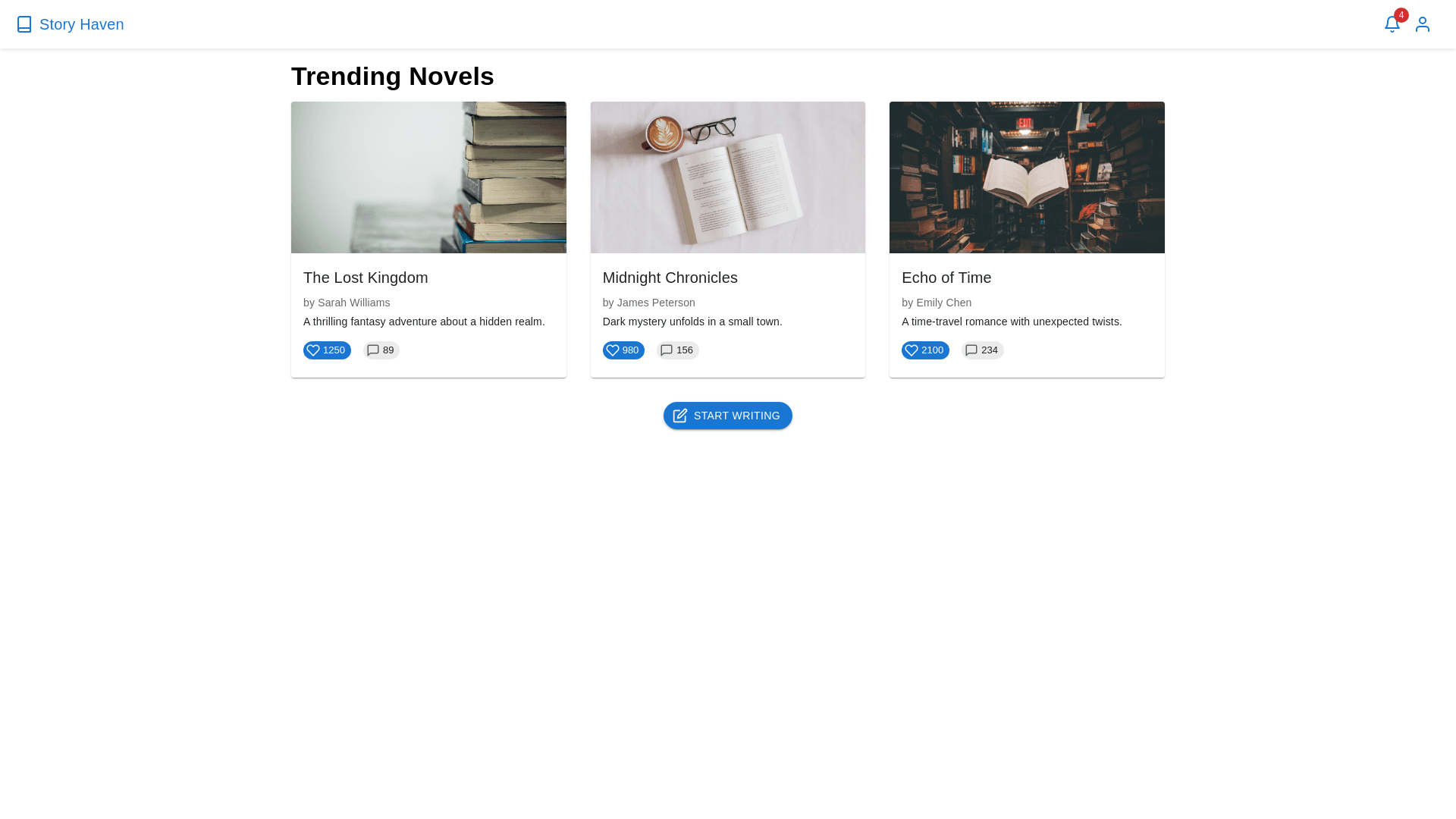Styled App Bar - Copy this React, Mui Component to your project
Here’s a detailed outline for the software documentation of your story/novel website project, designed to allow collaborative storytelling with voting and commenting features: # Story Novel Website Documentation ### Overview The website is a collaborative storytelling platform where users can write, publish, and receive feedback on novel sections. Each section can be commented on and upvoted, and alternate versions of the sections can be proposed by other users. The original author may choose to replace their section with the highest voted alternative, enhancing the collaborative and competitive nature of storytelling. ## 1. User Roles ### 1.1 Visitor Can view published sections, read comments, and upvote sections. Cannot create or propose alternate sections, nor comment on sections. ### 1.2 Registered User Can write, publish, and comment on sections. Can upvote sections and comments. Can propose an alternate version of any section. ### 1.3 Author Can write, publish, edit, and manage sections for their novels. Has the final authority to approve or reject alternate versions of sections. Can interact with users by responding to comments and managing votes. ## 2. Key Features ### 2.1 Section Based Writing *Section Structure:* Novels are divided into sections such as Monologue, Chapter 1, Chapter 2, etc. *Character Limit:* Each section has a specified character limit to encourage concise and engaging writing. *Save and Publish:* Authors can save drafts or publish each section independently. *Progress Locking:* To unlock subsequent sections, authors must publish the previous section. ### 2.2 Voting and Commenting System *Upvotes:* Each published section can be upvoted by users to show popularity or quality. *Comments:* Users can comment on sections to provide feedback and discuss the story. *Comment Moderation:* Authors can moderate comments on their sections, including deleting inappropriate content or flagging comments for review. ### 2.3 Alternate Version Submission *Alternate Proposal:* Any user who believes they can improve a section may submit an alternate version. *Upvoting of Alternates:* Alternate versions can be upvoted by the community, similar to the main sections. *Author Decision:* The original author can either keep their version or choose to replace it with the highest voted alternate version as the official one. ### 2.4 Version Management *Version History:* Each section retains a version history, allowing authors to revert to previous versions. *Official and Alternate Labeling:* Sections are tagged as "Official" or "Alternate," with the author’s chosen version marked as "Official." ### 2.5 Notification System Users and authors receive notifications for: New comments on their sections. New alternate versions proposed for their sections. Upvotes on their sections or comments. Section updates, including author approvals or rejections of alternate versions. ## 3. System Design ### 3.1 Database Schema *Users Table:* Stores information about registered users, including roles (Visitor, Registered User, Author). *Novels Table:* Holds novel metadata, including title, author, genre, and publishing status. *Sections Table:* Stores information for each section, including content, character count, publication status, version history, and upvotes. *Comments Table:* Tracks user comments on sections and includes fields for upvotes and moderation status. *AlternateVersions Table:* Contains alternate versions submitted by users, along with upvotes and status (Pending, Approved, Rejected). *Notifications Table:* Manages notifications for user interactions and section updates. ### 3.2 API Endpoints #### User Management *Register User*: /api/users/register *Login*: /api/users/login *Logout*: /api/users/logout #### Novel and Section Management *Create Novel*: /api/novels/create *Publish Section*: /api/sections/publish *Update Section*: /api/sections/update *Submit Alternate*: /api/sections/alternate/submit #### Voting and Commenting *Upvote Section*: /api/sections/upvote *Post Comment*: /api/comments/post *Upvote Comment*: /api/comments/upvote #### Notifications *Get Notifications*: /api/notifications/get *Mark Notification as Read*: /api/notifications/mark as read ### 3.3 Frontend Components *Home Page*: Displays trending novels, popular sections, and top rated alternates. *Novel Page*: Shows sections in a progressive layout, with options for reading, voting, and proposing alternates. *Section View*: Displays a single section, comments, alternate versions, and voting options. *Alternate Submission*: Allows users to submit an alternate version for a published section. *Notification Panel*: Lists recent notifications for user interactions and section updates. ## 4. Workflow 1. *Author Writes Section*: Author drafts and saves or publishes the first section, unlocking it for user interaction. 2. *User Engagement*: Users read the published section, comment, and upvote it if they like it. 3. *Alternate Submission*: Users can propose an alternate version of the section if they feel they can improve it. 4. *Voting on Alternates*: Community members upvote alternate versions. 5. *Author's Decision*: The author reviews the most upvoted alternate and decides whether to accept it as the new official section. ## 5. Error Handling *Invalid Input*: Return appropriate error messages for empty or malformed fields in section, comment, or alternate submission forms. *Unauthorized Actions*: Restrict actions like publishing or updating sections to registered users and authors only. *Alternate Conflict*: Ensure only one active alternate is allowed per user for each section. ## 6. Testing ### 6.1 Unit Tests Test APIs for each function: publishing sections, submitting alternates, voting, and commenting. Validate input constraints, such as character limits for sections and comments. ### 6.2 Integration Tests Simulate workflows to ensure smooth user interactions, including writing, publishing, voting, and approving alternate versions. ## 7. Security and Privacy *Authentication*: Use secure authentication methods for user login and registration. *Data Privacy*: Implement data protection measures, especially for sensitive information. *Spam Protection*: Introduce spam filters for comments and alternate submissions to maintain content quality. This documentation serves as a guide for developers and stakeholders, ensuring clarity and coherence in feature implementation and system workflows. create UI for this description
